Introduction
In India, many believe the seven days of the week—Sunday, Monday, and so on—have special spiritual or scientific powers. Some think Monday (linked to the Moon) is calm, while Saturday (tied to Saturn) is tough. This comes from astrology, where each day matches a planet, influencing things like weddings or work. But do planets really control our days?
During solar and lunar eclipses, they come with a set of beliefs and rules. Many people think these eclipses bring bad luck, spoil food, or even harm unborn babies. You might see families covering their meals, avoiding eating or prohibiting to do any work. This makes people think eclipses are dangerous times.
Similarly, Indian people follow Vastu Shastras, which says sleeping with your head towards the south is good for health because of Earth’s magnetic field. North is avoided as they claim presence of negative energy, and east or west have mixed effects.
As engineering students, let’s use science—physics, chemistry, and math—to uncover the truth. In second chapter of Shrimad Bhagwat Geeta, how lord Krishna emphasise on using discriminative intelligence to break free from ritual and fear belong to ignorance and to distinguish eternal truth (self) from temporary illusion (physical arrangement). Unquestioned, blind faith, fear-based practices go against the spirit of Sankhya-yoga (rational analysis), focuses on mental clarity, logic, and freedom from blind ritualism.
Besides of illiterate people, now days, even educated people in India — including engineers and science students — are blindly following and practicing beliefs without asking any real questions and seeking for help through these belief, distracting them from real and genuine solution.
Instead of promoting awareness, these ideas are spreading fear. Our news channels, social media, and even schools are filled with such content, while real science is ignored or misunderstood. This shows we are not just lacking science knowledge and temperament — we’re losing our scientific mindset.
The worst part is, people are calling superstition as ‘Indian tradition,’ and using spiritual texts like the Gita to justify unscientific claims. But the Gita itself teaches us to use logic, stay fearless, and rise above illusion. Right now, India is stuck between spiritual confusion and scientific misunderstanding — and we need to fix both.
In this article, I will discuss :
1. Solar and Lunar Eclipse
Physics of Eclipse
Chemistry: Food and Health Claims
Gravity Tides
a. Tidal Force Effects on Blood vs. Natural Physiology
b. Natural Blood Pressure Force : Driving Force for Blood Flow
2. Reality Of Sleeping Direction
Hemoglobin: Magnetic Physics, Coordination Chemistry, and Structure
3. Weekly and Day Based Superstitions
Briefing of weekly based belief
Reality of such scientific claim
Statistical Illiteracy: Misreading the Patterns
Confirmation Bias, Nocebo Effect and Patternicity : Psychology Aspect
Agency Avoidance : Philosophy
4. Comics against pseudoscience : Reality in Stories
5. Final Verdict
There is no scientific basis on how movement of planets or stars can influence people’s fate. There are no solid proof to believe that variation in forces or time of birth would influence the events in the years to come. A culture based on superstitions will do worse than one based on scientific knowledge. Astrology has no scientific basis.

1. Solar and Lunar Eclipse
Eclipses are simple astronomy. A solar eclipse happens when the Moon passes between Earth and the Sun, blocking sunlight. A lunar eclipse occurs when Earth comes between the Sun and Moon, casting a shadow. No demons are involved! Let’s check if they change anything big.
a. Physics of Eclipse
During a solar eclipse, sunlight drops a lot. The intensity of light (I) is given by:

where, P is the power of the Sun’s light and A is the area it covers.
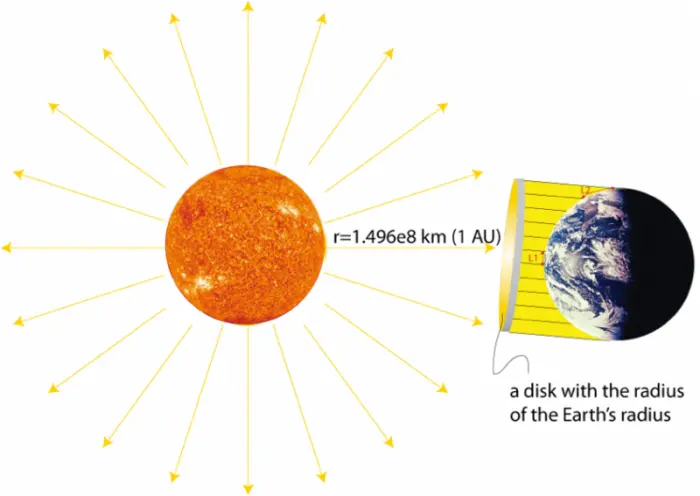
Area of disk same as of Earth's diameter :

In this case, Sun’s power is equal to 3.846 × 10²⁶ W, and Earth-Sun distance (r) is 1.496 × 10¹¹ m. So, solar intensity will be :

The total energy hitting the Earth in one hour (in watt-hours) is

At the peak of a total eclipse, light can drop to near zero for a few minutes, causing a temperature drop of 3-12°C. But does this change health? No—your body adjusts to such small shifts easily. We can calculate temperature drop using the boundary-layer cooling model, at different cooling depth, forming temperature drop gradient.

Parameters:
- Q (Blocked solar radiation) = 1350 W/m² (99% of solar constant 1365 W/m²)
- t (Totality duration) = 2 minutes = 120 s
- ρ (Air density) = 1.2 kg/m³
- c (Specific heat capacity of air) = 1005 J/(kg·K)
- h (Effective cooling depth) = 30 m

This matches observed drops in deserts (e.g., 2019 Atacama eclipse: 5.2°C) or clear-sky events. Meanwhile rate of temperature drop may decrease to 1-3 °C for humid or windy environment ( higher cooling depth, around 80-100 m), leading to slower cooling.
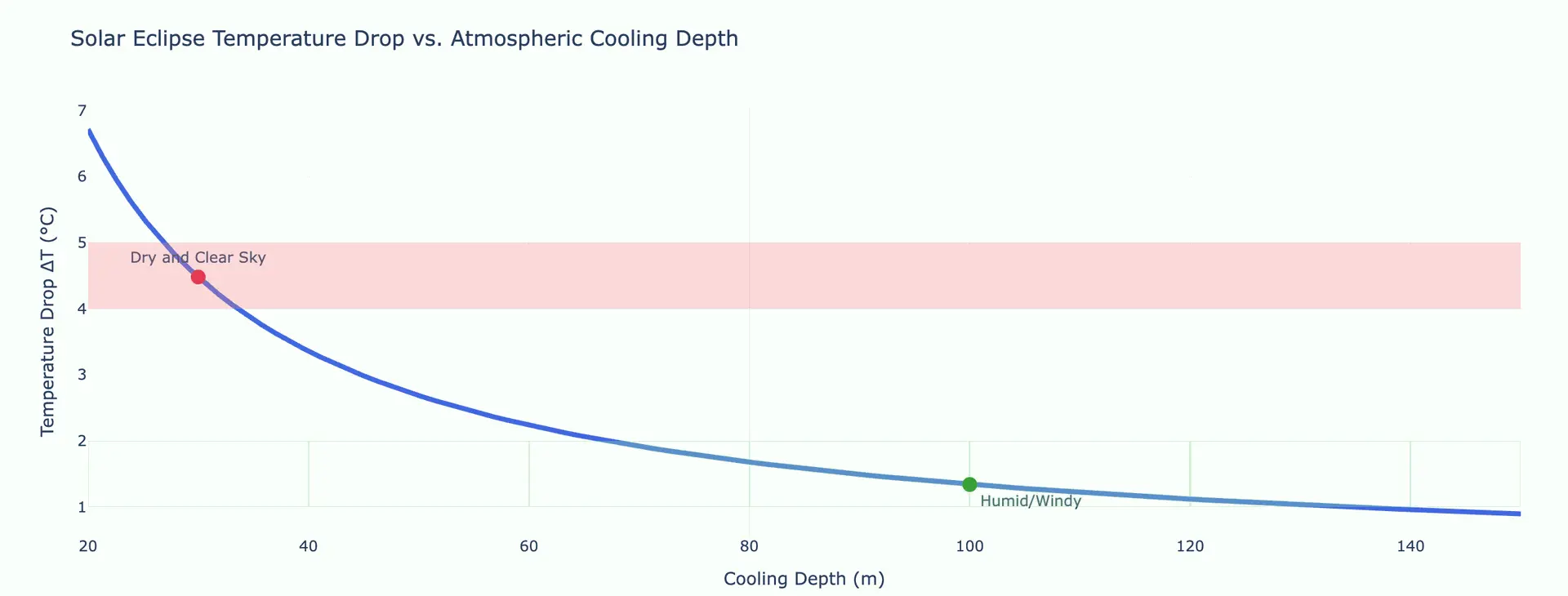
What about Earth’s magnetic field? The Earth's magnetic field intensity at the surface varies from 25 to 65 microteslas (µT). During an eclipse, solar wind (charged particles from the Sun) can cause a tiny variation, about 0.1-1 μT.
So, calculating magnetic force on dynamic tiny and charged particle (e.g., ions in blood) such that :

where :
- Charge (q) = 1.6 × 10⁻¹⁹ C (like an electron)
- Velocity (v) = 0.01 m/s (blood flow speed)
- Magnetic field (B) = 0.00006 T (60 μT, average with variation)
Force on single ion will be :

For (10^10) ions:

Comparing to gravity force such that :

This force is negligible—billions of times weaker than gravity (9.8 N/kg). Considering haemoglobin’s diamagnetism (susceptibility χ ≈ -10⁻⁶), as weak repulsion due to paired electron or low-spin effect.

whereas :
- Susceptibility: χ≈ -10⁻⁶
- Blood volume: V=0.005 m³ (5L blood)
- B-field: B=50 μT
- Gradient: ∇B≈ 0.000001 T/m (Earth's field gradient)

This confirmed no effects of magnetic field on health from solar eclipses.
This is way too small to affect your body, proving the “bad energy” idea wrong
b. Chemistry: Food and Health Claims
One of the prominent belief to be believed by most of the Indian people is that food gets contaminated or spoiled during eclipses. Let’s see if chemistry supports this. Food is made of water, proteins, and carbohydrates—stable molecules. An eclipse’s shadow or magnetic shift doesn’t trigger chemical reactions. Tests by food scientists show no change in pH, nutrients, or bacteria levels in covered vs. uncovered food during eclipses. So, the idea of “bad energy” spoiling food is just non-sensical.
What about pregnant women? Some think eclipses harm babies due to “rays” or energy. Biology tells us a fetus develops based on nutrients, oxygen, and genetics—not light or magnetic fields. No chemical or biological evidence supports fetal harm. These fears likely coming from old misunderstandings.
Study : Effect of Solar Eclipse on Food: A Scientific Study (Indian Journal of Traditional Knowledge, 2013)
" No significant differences observed in pH, protein, fat, carbohydrate content, or microbial counts between eclipse-exposed and control samples. The eclipse shadow does not alter food chemistry or safety."
Reference: Verma et al., Indian J Tradit Know. 2013;12(4):705-707
NASA Eclipse Science Page
"No physical mechanism exists for eclipses to contaminate food. The only change is darkness—identical to night. Any reported effects are psychological, not chemical."
Source: NASA, "Eclipse Misconceptions," 2017
Study : Pregnancy Outcomes During Solar Eclipses (University of Toronto, 1999)
- Method: Compared 1,200 birth records from regions experiencing total solar eclipses (1994–1995) vs. non-eclipse periods.
" Zero correlation between maternal eclipse exposure and birth defects, birth weight, or developmental abnormalities. Fetal health depends solely on biological factors—not celestial events."
- Reference: Bracken et al., J Obstet Gynaecol Can. 1999;21(5):447-451
"Birth defects arise from genetic, nutritional, or infectious causes. Electromagnetic fields below 1,000 µT—200x stronger than Earth's field—have no known impact on fetal development."
Source: WHO, "Environmental Health Criteria 238," 2020
c. Gravity and Tides
Some claim eclipses enhance the gravitational pull of the Sun and Moon, affecting tides or even body fluids, suggesting impact on health and body fluid.
The tidal force arises due to the difference in gravitational attraction across Earth due to the varying distance from the Moon or Sun. Basically, the side of an object closer to a massive body experiences a stronger gravitational pull than the far side, causing a stretching effect.

The tidal force depends on the gradient such that :
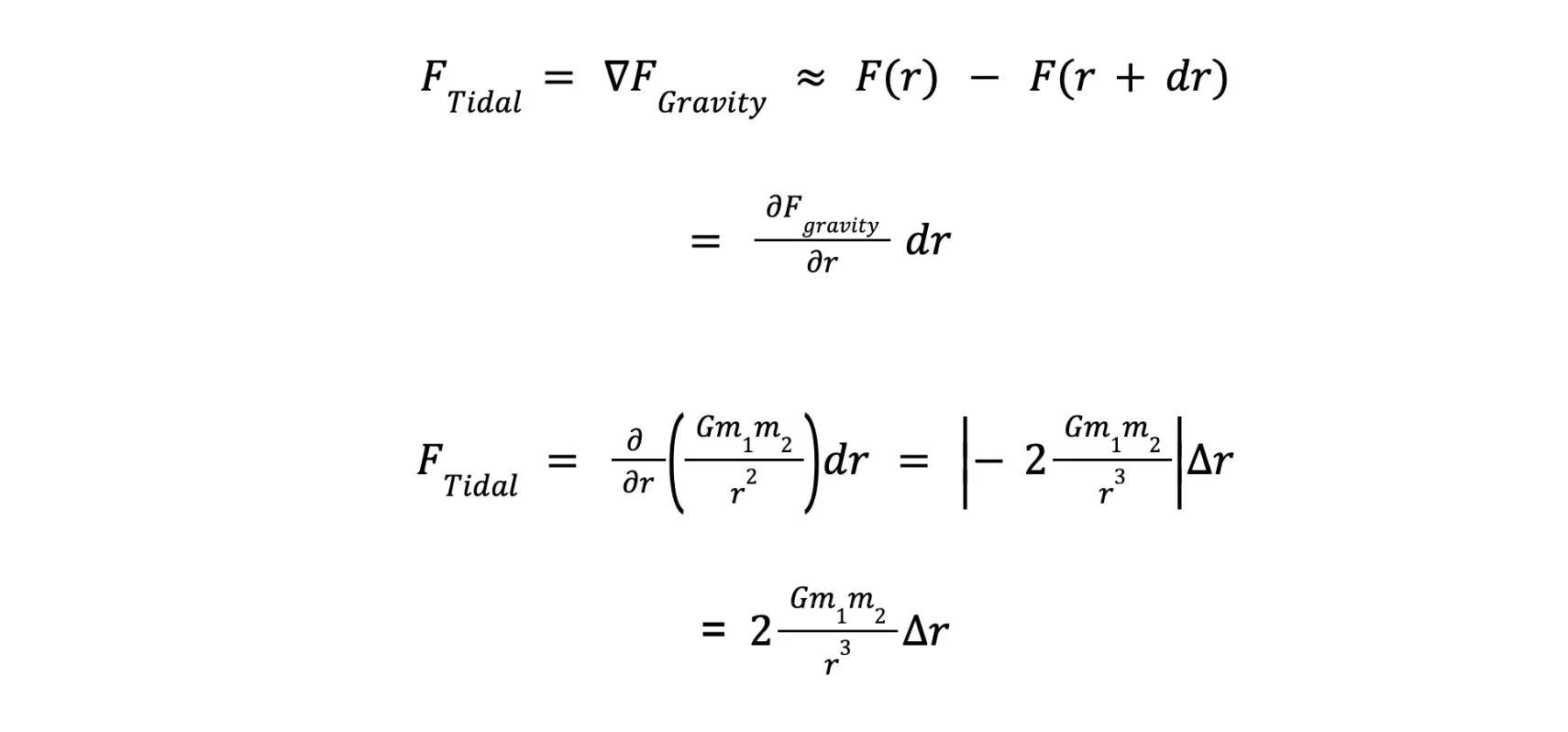
The tidal force per unit mass (tidal acceleration) is:

where Δr is the diameter of Earth (1.274 × 10⁷ m) and G = 6.674 × 10⁻¹¹ N·m²/kg² (gravitational constant). Here, m2 = mass of celestial body (kg) and r = distance to celestial body (m).
For Moon's tidal force (m₂ = 7.342 × 10²² kg, r = 3.844 × 10⁸ m, r³ = (3.844 × 10⁸)³ = 5.679 × 10²⁵ m )

Force on 70kg person :

For sun's tidal force (m₂ = 1.989 × 10³⁰ kg, r = 1.496 × 10¹¹ m, r³ = (1.496 × 10¹¹)³ = 3.347 × 10³³ m³ )

For 70kg person :

Combining combining sun and moon tidal force to evaluate effect of tidal force on particular person:

This small tidal forces during eclipses or non-eclipse have negligible effect on any human's biological activity or fluid level, weaker than a mosquito's weight (10^−3 N).
Tidal Force Effects on Blood vs. Natural Physiology
Total tidal force exerted on 1 litre of blood will be,

For 1 ml of blood,

Let's evaluate force required to move blood of 1 ml by 1 cm, occur due to pressure drop across as driving force, while must overcome viscous resistance of blood against blood vessel. Then comparing required force with tidal force acting on same mass of person, to analyse relative power of tidal power on health and body fluid.

As force is related to pressure drop, through poisuelle equation, we will try to establish relation between pressure drop and volumetric flow rate (m³/s), to model blood flow through cylindrical tube (veins).

So, rewriting equation of required force in term of volumetric flow rate (m³/s),
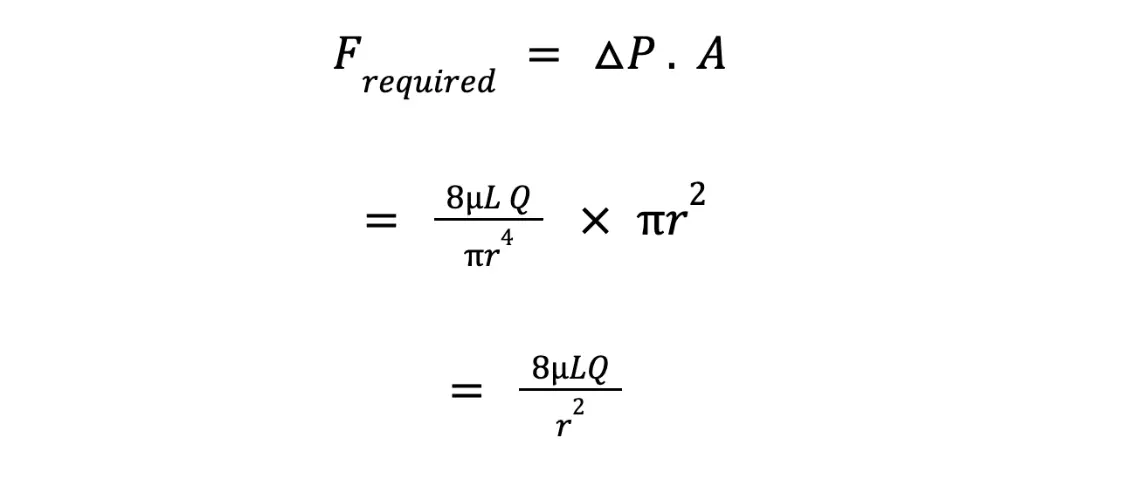
whereas,

and time taken to displace blood by 1 cm at speed of 0.1 m²/s, will be 0.1 sec.

At this condition,
- Dynamic viscosity of blood (μ) at 37 °C:
- Vein segment length (L): 0.1 m (10 cm)
- Displacement distance (d): 0.01 m (1 cm)
- Time (t): 0.1 s ( from blood velocity v=0.1 m/s)

Total volume of blood contained in 0.1 metre vein segment with vein radius of 0.025 m), will be 1.96 ml.
So, total force required to displace 1 ml of blood by 1 cm, will be

Natural Blood Pressure Force : Driving Force for Blood Flow
Generally, blood exert pressure about 12000 - 16000 N/m² against capillaries wall. Blood flows through a billion of parallel capillaries. Blood pressure exerts force perpendicular to vessel walls, not to move blood. The force driving flow comes from the pressure gradient (ΔP/L).

For pressure drop across 1 mm length of capillary (data taken from Guyton & Hall's Textbook of Medical Physiology [14th ed., pp. 168-170] )

Human body contains approximate 10-12 billion of blood capillaries (WHO, Human Hemodynamics, 2020).So, let's calculate number of capillaries required for 1 ml of blood to flow,

Area for one capillary of radius (3 × 10⁻⁶m), will be 2.826 × 10⁻¹¹ m². So, total cross section required for 1 ml of blood through 2 million of capillaries

So, total actual driving force will be,

Lets compare tidal force with every kind of possible force and conclude through tabular form.
Tidal forces are 18 million× weaker than blood pressure and 42,000× weaker than forces needed to minimally move blood. Eclipses or any kind of celestial blood cannot shift body fluids. Celestial tides are physically irrelevant to human biology.
"Eclipse tidal forces on body fluids are trillions of times weaker than routine physiological forces. They cannot influence health, energy, or behavior."— American Geophysical Union, 2023
"Tidal forces from eclipses or planetary alignments are irrelevant to human health. The force on body fluids is trillions of times weaker than natural forces (e.g., walking or blood pressure)."— American Geophysical Union, "Geophysical Tides and Human Health," 2021
"The force required to move blood is governed by viscosity and pressure—not celestial events. Eclipses cannot perturb blood flow, much less 'energy balance'."— American Geophysical Union, "Geophysical Tides and Human Health," 2021
While eclipses inspire awe, their gravitational effects are too small to measure on the human scale. Your body fluids remain unmoved – focus on enjoying the celestial show! 😉 😁
2. Reality Of Sleeping Direction
Vastu Shastras advises sleeping with your head south for health, claiming it aligns with Earth’s magnetic field, while north brings negative energy, and east or west have mixed effects. This belief suggests magnetic alignment improves blood flow or vitality. But physics and physiology proves this claim.
As in eclipse section, we already calculated force exerted due to earth magnetic field, getting 8 × 10⁻²³ N, negligible and billion times weaker than force to gravity and actual blood flow driving force due to pressure drop, hence no effect of magnetic field on blood flow and body fluid, and also there is no such kind of negative energy to be exist.
Rotating 180° reverses this force vector, would hardly cause any change in magnetic force applied.

Magnitude of this changes will be, 1.6 × 10⁻²² N per ion. In fact, hemoglobin's diamagnetism (χ=−10⁻⁶) is isotropic—it responds identically to fields from any direction. 'Alignment' is irrelevant.
Earth’s field varies slightly across your body of height 1.7 metre. So, for an ion moving from head to foot:

Where, Earth’s weak magnetic gradient (∇ B) ≈ 3 × 10⁻⁹ T/m across a 1.7 m.

Earth’s magnetic field is too weak to affect blood, hemoglobin, or ‘energy flow.’ Sleep comfortably in any direction.
Hemoglobin: Coordination Chemistry, Structure, and Magnetism
Hemoglobin (Hb) is a tetrameric and metalloprotein found in red blood cells, responsible for oxygen transport. Each subunit contains a heme group, which is an iron-containing porphyrin complex.
In structure of heme group, Central Fe²⁺ ion bound to four nitrogen atoms in a porphyrin ring (square planar). Histidine (His F8), a alpha-amino acid, binds below the plane (5th coordination site) and 6th site binds O₂, CO, or H₂O, forming octahedral structure.
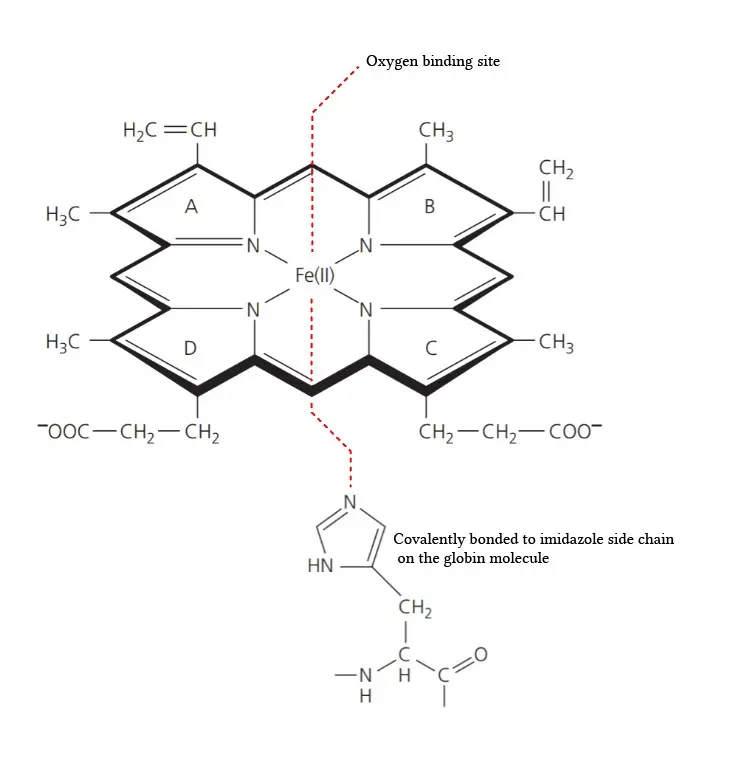
In oxyhemoglobin (oxyHb), when O₂ binds, it forms a bent end-on coordination (Fe-O-O angle ~120°).The Fe²⁺ moves into the porphyrin plane, pulling the proximal histidine and triggering conformational changes (influencing affinity of molecule for ligand). OxyHb is diamagnetic (no unpaired electrons) because the low-spin Fe²⁺ has all electrons paired.
While, the sixth coordination site is vacant in deoxyhemoglobin (deoxyHb), making it paramagnetic (has unpaired electrons) and Fe²⁺ is in a high-spin state. As high spin Fe²⁺ has a larger ionic radius, causing too large to fit in plane, leading to Fe²⁺ lies slightly out of the porphyrin plane.

Hemoglobin's iron (Fe²⁺) binds oxygen via a coordination bond with energy:

The maximum energy a magnetic field can impart to hemoglobin is:

For deoxygenated hemoglobin (paramagnetic, high-spin Fe²⁺):

While oxygenated hemoglobin (diamagnetic, μ≈0):

Net energy difference during binding:

Comparing magnetic influence to binding energy of coordinated bond ( O2-Fe),

Hemoglobin's oxygen-binding energy (0.7 eV) is 45 million× stronger than any influence from Earth's magnetic. This coordinated bond (112 kJ/mol) is stronger than hydrogen bonds (5–30 kJ/mol).
"Static magnetic fields below 1 Tesla (20,000× stronger than Earth’s field) have no measurable effect on human physiology, including blood flow or protein function."
— National Institutes of Health (NIH), Static Field Effects on Health, 2022
"The energy of Earth’s magnetic field (∼10⁻⁸ eV) is 10⁷ times smaller than the thermal energy (kBT) at body temperature, making it irrelevant to hemoglobin’s oxygen-binding kinetics."
— American Physical Society, Biomagnetic Myths, 2023
Weekly and Day Based Superstitions:
Briefing of weekly based belief :
Weekly beliefs in India built a rich cultural impact, linking days to divine and cosmic forces. Indian tradition assigns each day of the week to a deity and planetary energy, shaping auspicious and inauspicious outcomes.
Monday honors the Moon and Lord Shiva, believed to enhance peace but risk emotional instability if neglected. Tuesday, tied to Mars and Hanuman, is deemed inauspicious for haircuts or travel, fearing anger or accidents while Saturday, ruled by Saturn and Shani, is avoided for new ventures due to hardship.The moon’s night phases amplify these beliefs, with full moons linked to heightened energy and new moons to introspection, influencing rituals.
Reality of such scientific claim:
We’ve established that eclipses and sleeping directions lack biological impact—there’s no magnetic pull, negative energy, UV radiation, or frequency from planets affecting human physiology. Claims of Mars causing Tuesday mishaps or Venus boosting Friday luck are baseless, as outcomes hinge on actions, not celestial alignment. Health, wealth, and success stem from effort—diet, skills, and planning— not planetary whims, debunking the notion that cosmic forces dictate our fate.
Statistical Illiteracy: Misreading the Patterns
Superstitions persist not just due to lack of education but through statistical illiteracy, a pervasive issue even among educated Indians. A lack of understanding of probability, correlation, and confirmation bias can lead to the prevalence of superstitious beliefs and practices.
As the Tripura Commission for Women revealed, 64.7% of educated youth believe in witchcraft, despite Tripura's 96.8% literacy rate (2023)—proving that degrees alone cannot cure statistical illiteracy. There has been reported 8 case of witchcraft murders in Tripura, 2023. This is the cost of mistaking rote learning for rationality.
Article : Statistical Literacy – A Vital Ingredient for an Informed Indian Citizenry" by P.C. Mohanan (published January 30, 2023, The Hindu Centre)
Mohanan says, “Statistical literacy is not just about understanding numbers but also about grasping the context in which they are presented,” and further argues that ,“Statistical illiteracy cripples India’s democracy — enabling misinformation, flawed policies, and pseudoscience.The lack of statistical literacy in India is a significant barrier to becoming a knowledge society,” aligning with the need to address biases in your data.
Further, he quoted, "During demonetization 2016, the public misinterpreted the RBI’s report that 99% of cash returned to banks as a success, ignoring massive job losses and economic disruption. Similarly, during the COVID-19 crisis, a lack of understanding of excess death models led to denial of the true mortality toll. Such ignorance weakens democratic accountability, hides policy failures, silences democratic critique and fuels misinformation."
He advocates for action, stating, “Data journalists have a critical role in ensuring that data is not misrepresented in public discussion,” and calls for, “Policy attention is needed to integrate statistical literacy into education and public awareness."
Blending of statistical literacy into education, is must for encouraging critical thinking and challenging irrational beliefs.
When something rare or surprising happens — many people jump to mystical or supernatural explanations ("It must be fate", "It’s a sign", "I have mystic powers"). But David J. Hand, a mathematician and statistician, argues in his book The Improbability Principle that these rare events are not miracles at all—they are mathematically inevitable. So, David Hand proposed five laws that explain why seemingly impossible things happen all the time:
Laws | Comment | Example |
Law of Inevitability | With a large enough number of opportunities, even highly improbable events become likely to happen. | The chance of being struck by lightning is low, with billions of people on Earth, it's obvious that some will be struck multiple times. |
Law of Selection | We often focus on specific outcomes after they've happened, making them seem more significant than they were before. | Remembering a dream of a specific event that later occurred, while ignoring all the dreams that didn't come true. |
Law of Near Enough | We tried to correlate similar events together, even if they aren't exactly the same. | If you predict an event will happen and something similar occurs, you might still consider your prediction to be correct. |
Law of Probability Leveraging | Minor factors can have a significant impact on whether something happens or not. | Dreaming of a friend is more likely if you talk to them regularly. The event feels rare but is actually probable. |
Law of Inevitability | This law simply states that something must happen, given enough possibilities. | Even if the chance of winning the lottery is low, someone wins every week because so many people play. |
Overall, the Improbability Principle encourages us to think more critically about coincidences and rare events, telling that they occurred as a result of statistical principles rather than supernatural forces — it’s just math playing out over millions of trials.
Confirmation Bias, Nocebo Effect and Patternicity : Psychology Aspect
Confirmation bias is the tendency to favor information that confirms existing beliefs or values. It leads people to seek out, interpret, remember, and give more weight to evidence that supports their views while ignoring contradictory evidence. This bias can affect decision-making and judgment, often leading to inaccurate conclusions and reinforcing pre-existing opinions. Individuals recall failures on perceived "cursed" days while ignoring numerous successes.
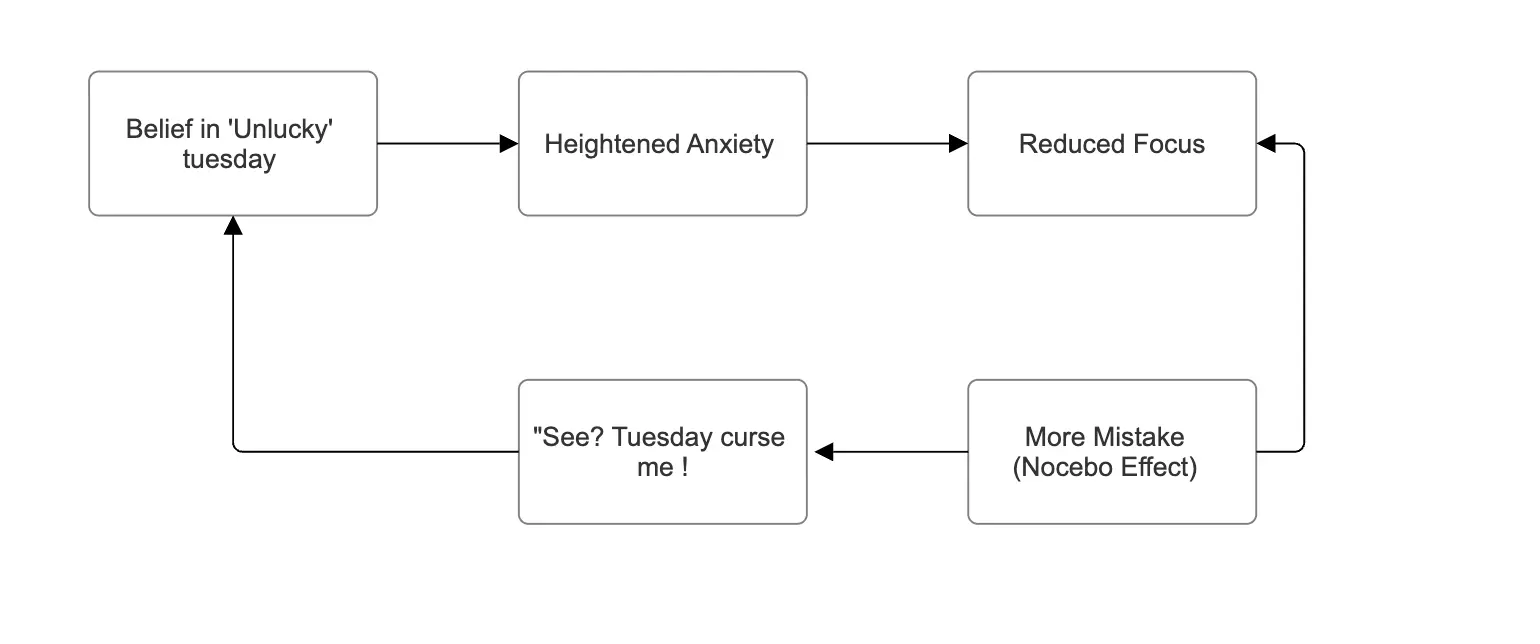
Patternicity, in psychology, refers to the human tendency to find meaningful patterns in random or meaningless data. It's a cognitive bias where individuals perceive order and connections where they may not actually exist. Patternicity is a natural part of human perception, where the brain constantly trying to make sense of the world by identifying patterns. This can manifest as seeing faces in clouds, interpreting random sounds as voices, or finding hidden meanings in seemingly random events.
While pattern recognition is crucial for learning and adaptation, patternicity can lead to misinterpretations and false beliefs. Some common example of patternicity:
- Pareidolia: Seeing meaningful images, like faces, in random objects or patterns.
- Apophenia: Finding meaning in random data, like interpreting coincidences as significant events.
- Believing in conspiracies: Seeing hidden patterns and connections in news or events that are not actually there.
A type I error, or a false positive, is believing something is real when it is not (finding a nonexistent pattern). A type II error, or a false negative, is not believing something is real when it is (not recognising a real pattern—call it “apatternicity”)
Culture Modeling
According to recent research on superstitution among young Indian adults (Chelwani et al., 2023,The International Journal of Indian Psychology), this study found no link between anxiety and superstitious beliefs. Instead, superstition appears to be primarily transmitted through cultural modeling – we unconsciously adopt behaviors from family and society without questioning. Due to this reason, educated individuals still follow rituals: they're learned reflexes, not anxiety coping mechanisms. The actual driving is social learning, not emotional distress.
Dataset : 232 participant (All literate Indians, No NRI or Non-indian National, No record of a chronic physical and psychological illness.
- No significant correlation between trait anxiety and superstitious beliefs (r=0.043, p=0.514).
- Rational Engagement (r=-0.197, p=0.005) and Rational Ability (r=-0.183, p=0.005) had weak negative correlations with superstitious beliefs., which implies promoting rational thinking can reduce superstition.
- Experiential Engagement and Ability showed no significant correlation
Agency Avoidance : Philosophy
Agency avoidance refers to the tendency to relinquish personal responsibility by attributing life’s outcomes to external, often supernatural forces (e.g., fate or planetary influences) rather than individual actions. This contrasts with the philosophical teaching of Vedanta, including Bhagwat Geeta (Chapter 2 Verse 42-23 and 47) which emphasises on action (karma) without attachment to results and critiques chasing rituals and belief driven by fear, uncertainty, ignorance, and irrationality over proactive effort and critical thinking.
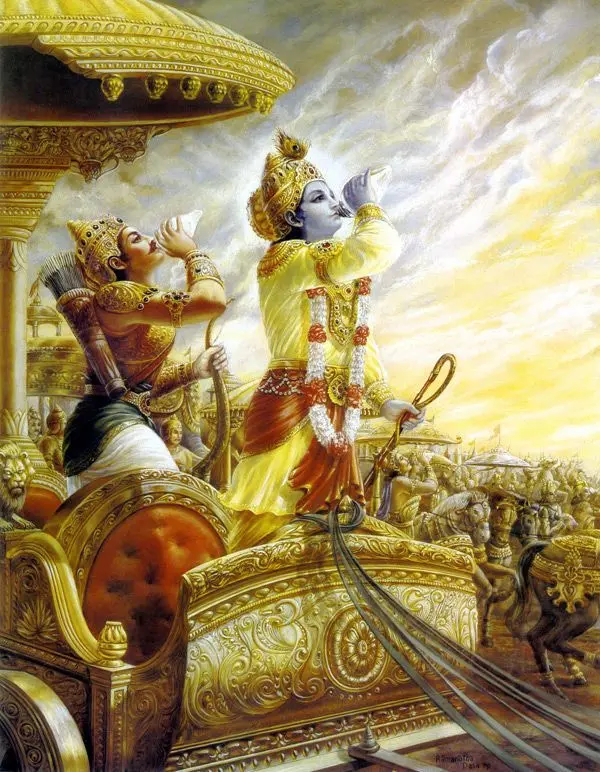
You have a right to perform your prescribed duties, but you are not entitled to the fruits of your actions. Never consider yourself to be the cause of the results of your activities, nor be attached to inaction. So Shree Krishna advises Arjun to give up concern for the results and instead focus solely on doing a good job.
(Bhagavad Geeta, Chapter 2-47)
Those with limited understanding, get attracted to the flowery words of the Vedas, which advocate ostentatious rituals for elevation to the celestial abodes, and presume no higher principle is described in them. They glorify only those portions of the Vedas that please their senses, and perform pompous ritualistic ceremonies for attaining high birth, opulence, sensual enjoyment, and elevation to the heavenly planets.
(Bhagavad Geeta, Chapter 2, 42-43)
This teaching encourages proactive effort and self-reliance. However, modern interpretations often misinterpret this into an obsession with fate, where individuals rely on astrological alignments or rituals to dictate their paths. Hence, this connect agency avoidance to concept of temporal fatalism and cosmic justice fallacy.
Temporal fatalism, in philosophy, is the belief that the future is fixed and unchangeable, just like the past, and that human actions cannot alter its course. If temporal fatalism is true, then our choices and actions have no real impact on what will happen, as the future is already set in stone. This can lead to questions about free will and moral responsibility. This might convince Individuals to believe that interfering or speaking about future events could "tempt fate" or make negative outcomes more likely.
Let's discuss cosmic fallacy justice— based on belief where the universe or a higher power ensures fairness or domination—is often tied to superstition, leading to the fallacy of attributing random events to a predetermined cosmic plan of reward and punishment. The idea that past actions inevitably cause future upcoming trembles, without clear links, fits this fallacy and assumes the universe operates on a balanced karmic system where specific days or celestial events determine outcomes, ignoring structural and social real disparities.
However, the fallacy becomes clear when comparing lived experiences and start doing rational analysis, addressing real and complex root for cause of problem. A Mumbai slum resident’s fate—marked by poverty, lack of healthcare, and labor—undoubtedly differs from Mukesh Ambani’s, shaped by wealth and privilege. Structural inequality, not planets or universe, drives these disparities.
Superstitions reflect cognitive biases, existential fears, and now mental weakness.

Swami Vivekananda
Indian philosopher and monk
"Astrology and all these mystical things are generally signs of a weak mind; therefore as soon as they are becoming prominent in our minds, we should see a physician, take good food, and rest."
Many Indians practices weekly-based supersitions like avoid shaving on Saturdays or cutting nails on Tuesday. But such rules are cultural, not spiritual or scientific -significance. Vedas and Upanishads, even core Puranic never mention such kind of teachings or rules. They teach Atma-Jnana (self-awareness) of eternal (atmana), Viveka (discernment), and detachment from blind rituals, ego, ritualism while giving no importance to physical arrangement or belief. Ancient Hindu calendars were lunar and solar based, focusing on tithi (day), nakshatra (star constellation), Paksha (fortnight, 15 days), Masa (month, 2 Paksha, 30 days), not Monday-to-Sunday cycles, instead, it were borrowed later, likely through Greek, Babylonian, and Roman contacts.
Time Cycle in Hindu Cosmology: From Nimisha (smallest unit) to Mahā-Kalpa and Pralaya (Final Dissolution);
Reference : Bhagavat Mahapuran (Skhand 3, Chapter-11); Corroborated with Vishnu and Matsya Purāṇas; Compiled and Illustrated by Science Mania.
Purpose : For educational use. This time model represents cyclical Hindu cosmology and is not intended as literal astronomical measurement.
True spirituality lies in truth, self-introspection, questioning, compassion, and inner discipline. Practicing them isn’t wrong — but blindly calling them “scientific” or “scriptural” is misleading.They’re not foundational to Hinduism's core spiritual texts.
Ironically, many follow these customs but ignore even simple ethical teaching like avoiding greed, compassion to animals, selfless service, truthfulness, cleanliness. Otherwise superstition will replaces self-inquiry, turning external habits into false measures of faith and outward habits overshadow inner evolution.
Increasing human’s never-ending greed, animal cruelty... has amplified climate change... Hence, people need to change their central mindset... rather than false promise and hope.
COMICS AGAINST PSEUDOSCIENCE : REALITY IN STORIES
"Attribution Error" – A comic exposing how superstition distracts from real solutions.
Final Verdict
- Eclipses and Health: Solar and lunar eclipses do not affect food safety, human physiology, or pregnancy outcomes. Recent scientific research and universities studies suggest there’s no physical mechanism for harm—only psychological effects driven by fear and tradition.
- Sleeping Direction Myths: Claims that sleeping with your head in a certain direction impacts health are not supported by physics or biology. The Earth’s magnetic field is far too weak to influence blood flow or “energy” in the body.
- Weekly Superstitions: Assigning spiritual or scientific significance to days of the week is a cultural construct, not a scientific, spiritual or scriptural reality. Success and well-being depend on proactive effort and rational-based decision, not planetary alignment.
- Statistical Illiteracy: Superstitions persist even among the educated due to misunderstanding probability, confirmation bias, and cultural modeling. Promoting statistical literacy is essential to challenge these beliefs.
- Scriptural Context: Core spiritual texts like the Bhagavad Gita promote rational analysis and self-inquiry, not blind ritualism or fatalism. True spirituality is rooted in questioning, compassion, and self-awareness—not in fear-based rituals or pseudoscience.
"Let rationality be your first ritual—question boldly, think clearly, act wisely."
- Jai Hind, Jai Vigyan
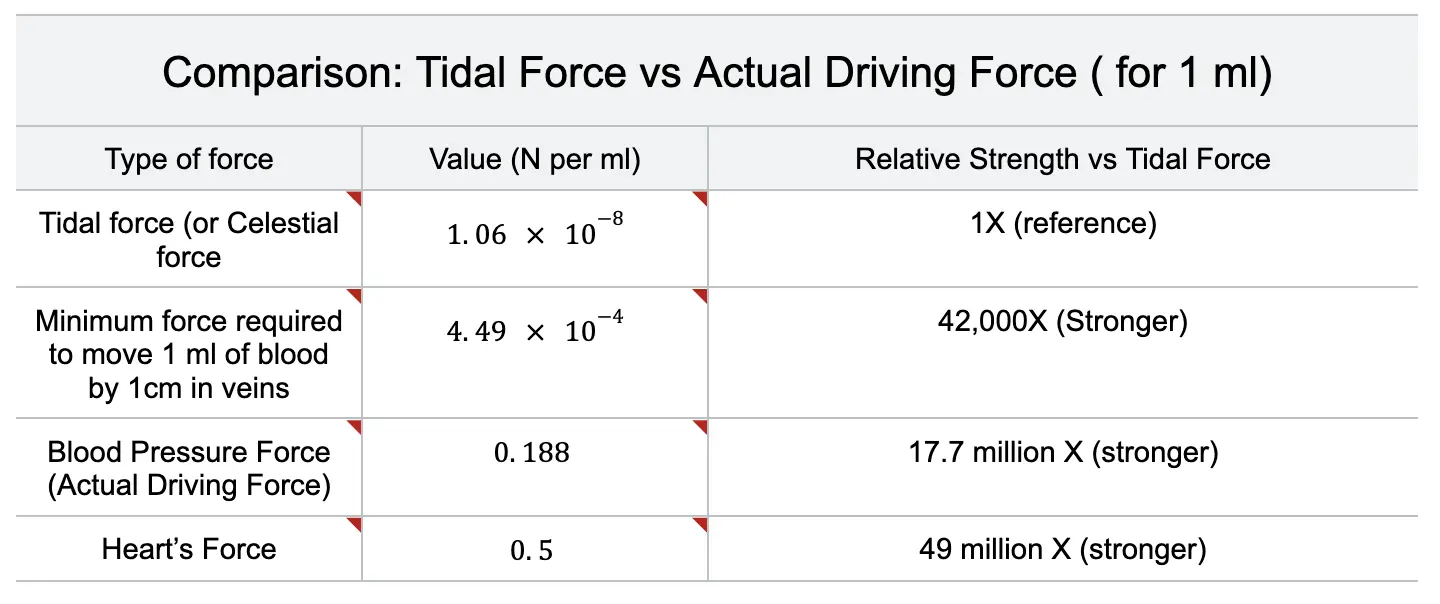
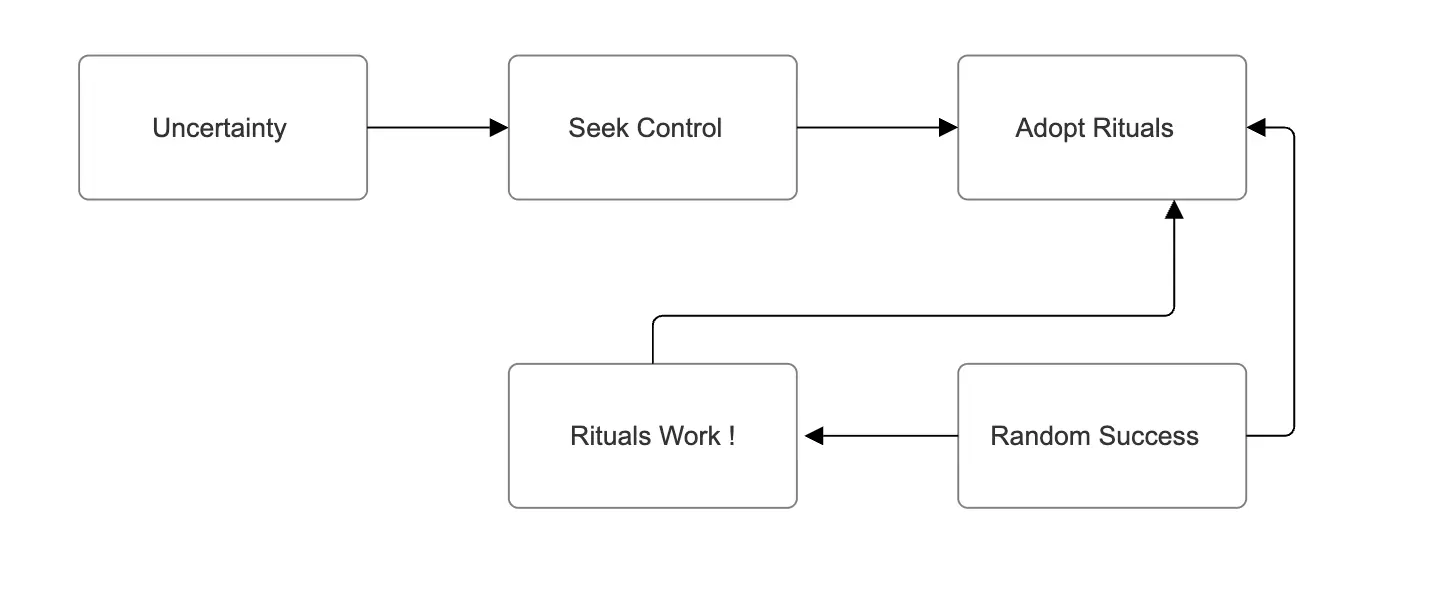

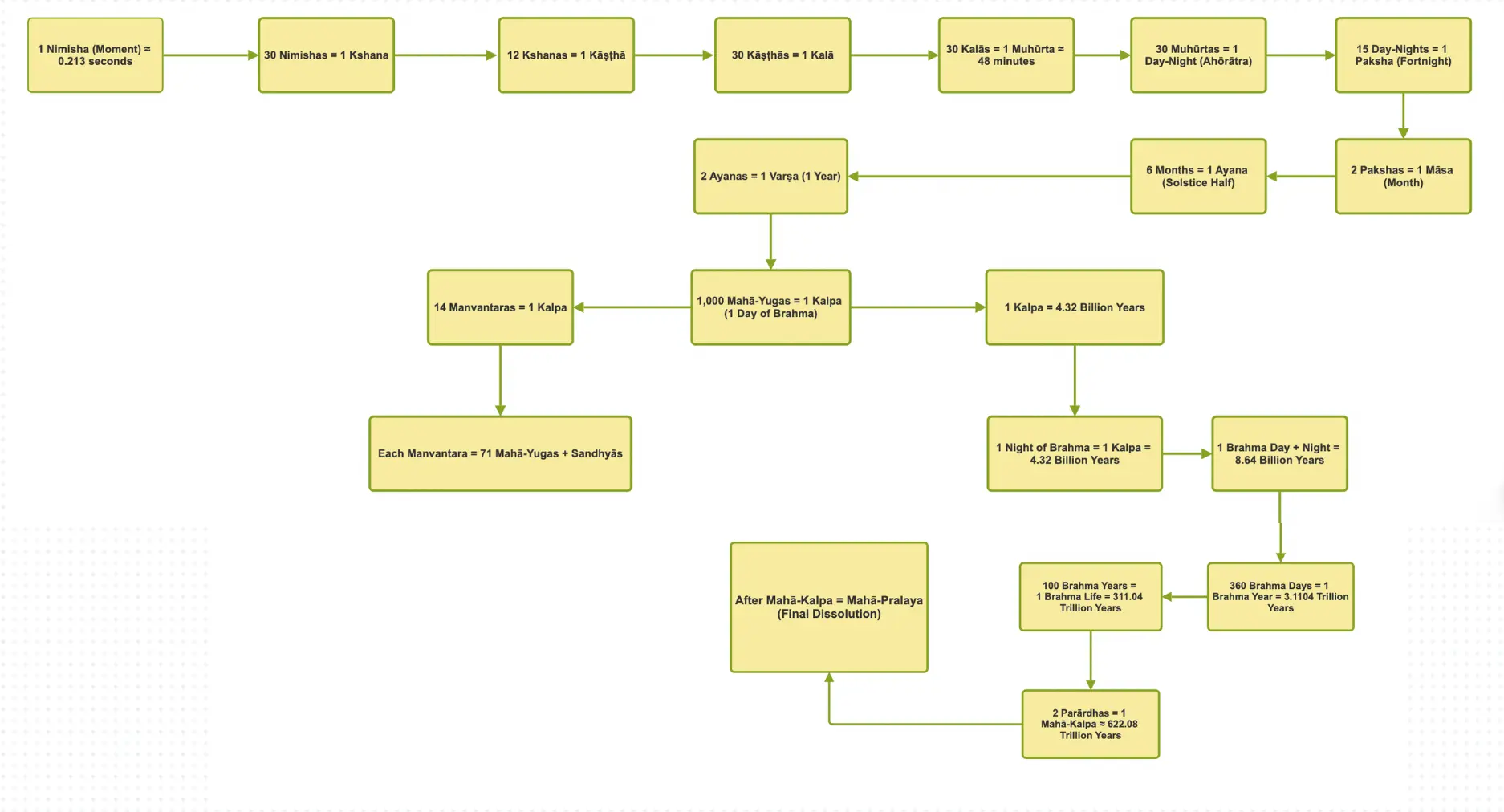
Attribution Error : No Scientific, Scriptural, or Spiritual Significance in eclipse, weekly based belief and sleeping direction.